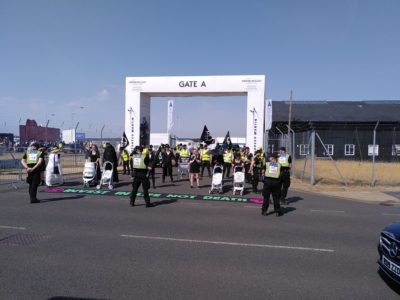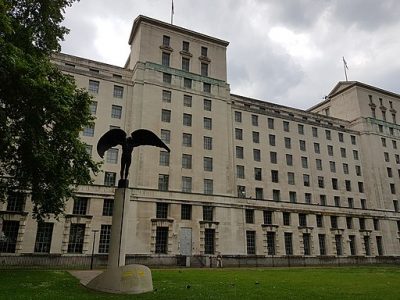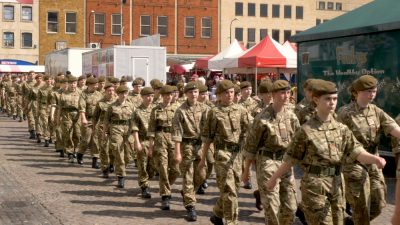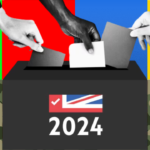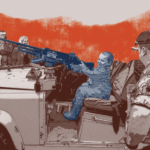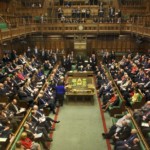Military activity in UK schools
ForcesWatch comment
The encroachment of the UK military and ‘military ethos’ on the UK education system means that alternatives to war and peaceful ways of resolving conflict will be more difficult for young people to explore.
Young people – children – around the world encounter the military and military approaches in many different ways, from the presence of military personnel and hardware in public spaces; to military youth groups such as the cadets; Armed Forces advertisements online and on television; video games developed by or with the military; and military involvement in education. They are encouraged to see the military and military approaches as normal, necessary, often the best solution to problems/conflicts, and – crucially – to be supported, not questioned.
A recent book by War Resisters’ International book, Sowing Seeds: The Militarisation of Youth and How to Counter It (2013), shows – through articles, surveys, images, and quotes – how young people around the world are experiencing these encounters, and how this privileging and lack of balance can be challenged. One chapter focuses in part on the military’s presence and influence in Education, which is a primary way in which they recruit and imbue a sense of uncritical pride or admiration towards the Armed Forces among future adult citizens. (You can read the book for free, or buy a hard copy).
This is very relevant to my work at ForcesWatch, a research and campaigning organisation focusing on the ethics of military recruitment in the UK. As Education Campaign worker, my main task is running the Military Out Of Schools campaign, which seeks to get people to question whether military and military-style activities in schools are appropriate – are they in the best interests of young people? The Army, Navy and Royal Air Force between them made around 11,000 visits to UK secondary schools and colleges in 2011-12. The distribution of visits is uneven: in some areas a very high proportion of schools and colleges are visited, sometimes multiple times in the same year (in Edinburgh 96% of state secondary schools were visited between 2010-2, on average six times over the two years; one school was visited 22 times). Private schools are visited proportionately less, and less frequently. The visits range from presentations on life in the Armed Forces to outdoor team activities. The Ministry of Defence admits that the two main outcomes of these visits are recruitment and ‘providing positive information to influence future opinion formers’. (see here for references, and to read more about these visits – including concerns that they raise).
The Ministry of Defence deny that the Armed Forces recruit during these visits, and insist that they only visit when invited, but both of these claims are misleading. Although pupils do not sign their contract on school premises during the visit (the MoD’s definition of recruitment), many of the school visits involve a recruitment element such as a mention of how to sign up. Recruitment can be a gradual process – indeed in 2007 the then-head of Army recruitment strategy Colonel David Allfrey said ‘Our new model is about raising awareness, and that takes a ten-year span. It starts with a seven-year-old boy seeing a parachutist at an air show and thinking, ‘That looks great.’ From then the army is trying to build interest by drip, drip, drip.”’ In this sense a school visit can be a later stage in a process that started much earlier. Regarding the second claim, it’s true that the Armed Forces only visit when they have an invitation, because otherwise they would be trespassing! However, they usually initiate contact with the schools, so it is very much a solicited invite, only possible thanks to the huge amount of money in the MoD’s ‘youth engagement’ budget. The fact that the MoD resort to this obscure reasoning indicates that they are aware that there would be significant public uneasiness if the fact that their visits had a significant recruitment element and that they were pushing hard to be admitted to schools in the first place. (See here for an in-depth deconstruction of the MoD’s claims not to recruit in schools and to only visit when invited)
A new development in the military influence in UK schools is the government’s ‘Military Ethos in schools programme’. This is partly a response to perceived poor discipline and attainment in some schools, and includes initiatives such as Troops to Teachers (fast-tracking ex-Armed Forces people into teaching jobs), the expansion of the Combined Cadet Force units into 100 state schools (in the past they’ve mostly been based in private schools), military-style activities for ‘disengaged’ or ‘at risk of becoming disengaged’ pupils (including ‘Challenger Troop’ – activities in military uniform instead of lessons), and ‘exploring how academies and Free Schools can use their freedoms to foster a military ethos and raise standards’. Labour’s ‘Service Ethos’ policy proposal is very similar, focusing on Service Schools, the Combined Cadet Force, and Military Mentors. (See here for videos on Troops To Teachers, the Combined Cadet Force, and alternative provision with a military ethos) There are currently over 250 CCF contingents, many of which have Navy and Air Force units as well as Army units (the latter are the most numerous), and involve around 45,000 pupils. In addition, there are ‘at least’ 272 community cadet units which are based on school premises but run outside school hours.
The big question is: who really benefits from all this? In their 2011 ‘Youth Engagement Review‘ the MoD only mention young people’s personal and social development as an additional or incidental outcome, after the ‘two clear defence outcomes’ of raising ‘awareness of the Armed Force’ role in the world and the quality of its work and people, in order to ensure the continued support of the population; and recruitment of the young men and women that are key to future sustainment and success’, the same two main outcomes acknowledged for their school visits. In contrast, the Department for Education, which is behind the Military Ethos in Schools initiatives, state that their core values associated with the military – ‘loyalty, resilience, courage and teamwork, to name but a few.’ – will ‘help raise standards and tackle issues such as behaviour’, and that ‘By improving pupils’ behaviour, and instilling a sense of service to others, the impact will also be felt across schools and the wider community.’
Two outcomes of the Military Ethos programme not stated explicitly by the DfE, but noted in two of the main documents which they say informed the policy, are recruitment, and providing employment for veterans: ‘[Ex-soldiers in schools] could also relieve the chronic recruiting problems faced by our armed forces…Knowing (and probably respecting) someone who has had a successful military career would ease some of the difficulties faced by the armed forces in finding suitable recruits.’; ‘[the programme] would create an additional incentive for joining the UK’s Reserve Forces by providing significant employment opportunities and a clear career path for those considering membership.’
It is part of schools’ duty of care to present a balanced view of life in the Armed Forces and of the realities of war: the 1996 Education Act demands that ‘where political issues are brought to the attention ofpupils… they are offered a balanced presentation of opposing views’. This is particularly pertinent given the recruitment aspect of the military’s activity in schools, as it is often the youngest recruits from the most disadvantaged backgrounds who are most at risk of death and serious mental and physical injury, due to their over-representation in the most frontline combat-exposed sections of the Armed Forces, such as the Infantry (see our reports), not to mention the uniquely restrictive ‘terms of service’, which – if broken – can lead to up to life in prison. Already given little attention, there is a danger that as military approaches further encroach on UK schools, discussion of these important issues will be overlooked even more. (See here for a more detailed critique of the military’s varied influence in UK schools)
Another issue is the cost to the taxpayer, at a time when so many youth services are experiencing cuts. It is difficult to calculate the cost of Armed Forces visits to schools, but Service Presentation Teams represent some of the highest of the MoD’s youth engagement – ‘£18 per student per presentation’ (though ‘[i]n some cases schools bear all of the costs’) – but they are deemed worth it as one of ‘those quality and memorable activities which involve personnel…the best way of conveying our information is through the medium of military and civilian personnel who can add veracity to statements and imagery, and allow the all important discussions with young people’. The CCF cost the MoD £26 million per year – though this does not include staffing, accommodation or transport – approximately £557 per cadet. The MoD states that this ‘appear[s] relatively good value compared to other publically funded youth providers’, but they are only comparing it to the Canadian Cadet Force, and National Citizen Service, and are not factoring in the costs that schools have to cover – ‘A new 120-strong cadet force unit would cost a school around £60,000 per year’. The Military Ethos programme is costing £26.45 million up until 2015: £10.85 million for the new CCF contingents; £12.4 million for Troops to Teachers Initial Teacher Training; and £3.2 million on four alternative provision schemes.
Young people are obviously the ones most affected by all this. Some have asked hard questions of military visitors to their schools, and The Woodcraft Folk have started their own Military Out Of Schools campaign. Other young people just haven’t had the opportunity to decide what they think, perhaps because theyhaven’t been told about the downsides of joining the Armed Forces, or explored the ethical questions that war and the preparation for war raise. One way that we at ForcesWatch are helping them to do this is through a short documentary film that we’ve commissioned on what teenagers in the UK think about the military’s engagement with them, which is being made by a team of teenage journalists. We hope that the film – which will be available to watch for free online – will help to give them a voice, and make other young people interested in the issue. We also do workshops in schools and at youth events looking at how and why the military engage with young people, and we recently held a conference on ‘Militarisation in Everyday Life in the UK’, which had youth engagement as one of its focuses, and which involved participants of all ages and from academic, campaigning, and faith backgrounds.
One other thing to mention is that we are writing a report on the presence and influence of the military in UK universities, which includes several parallels to that in schools, such as paying students through their undergraduate studies on the condition that they serve for at least three years afterwards (similar to the Armed Forces Sixth Form bursaries), and running University Service Units (the officer-level version of the Combined Cadet Force), as well as being the focus of a lot of science and engineering research.
If you’d like to share your experiences of the military in schools, colleges, or universities, or ask any questions, email education@forceswatch.net.
See more: cadets, military in schools/colleges, education, military ethos
Like what you read?
> Sign up for our newsletter or blog notifications
> Support our work – from just £2 a month

